
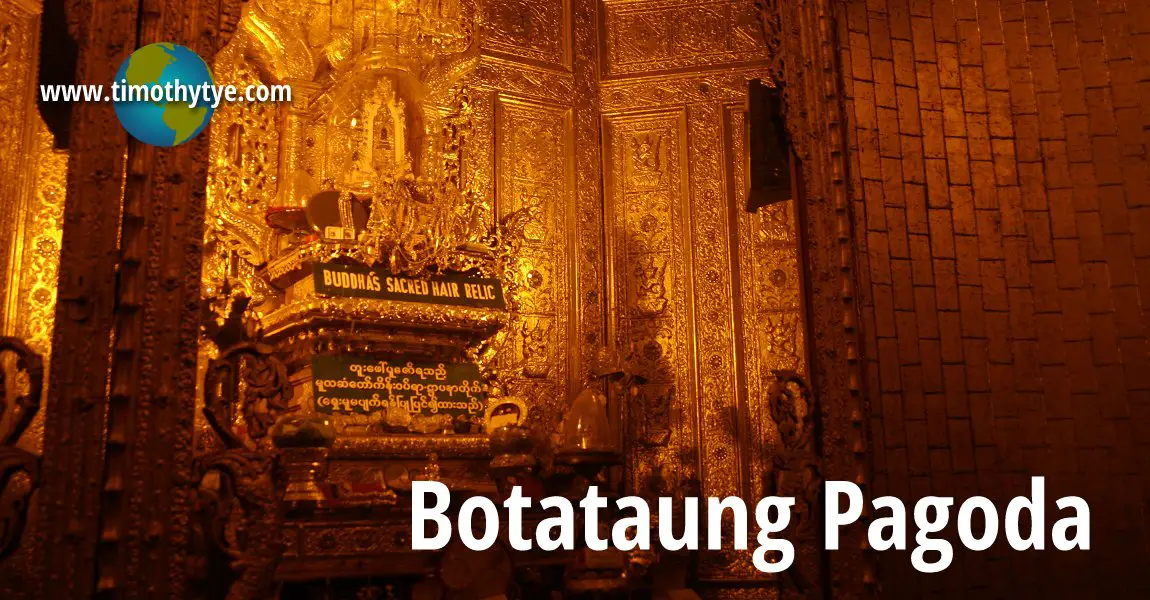 The Buddha hair relic at Botataung Pagoda, Yangon (20 November, 2003)
The Buddha hair relic at Botataung Pagoda, Yangon (20 November, 2003)
Botataung Pagoda (GPS: 16.76842, 96.17186) is a Burmese Buddhist temple in Yangon, Myanmar. It was built to commemorate the 1000 military officers that formed a guard of honour to welcome the landing in Burma of the relics of the Buddha brought over from India more than two thousand years ago by eight Indian monks. The name Botataung comes from the Burmese words "bo" meaning military officer, and "tataung" meaning thousand.
According to ancient chronicals, the Buddhist king Sihadipa gave one of his ministers a sacred hair of the Buddha and two body relics. This minister, renowned for his goodness and faith, consulted a famous religious leader and, on his advice, chose the Botataung Mount on the bank of Rangoon River at a distance of one thousand tars (7,000 cubits) in a South-Easterly direction from the Shwedagon Pagoda to enshrine the sacred relics. So the relics were buried here for the past two thousand years.
The Botataung Pagoda was a famous landmark on Rangoon's waterfront. Botataung is situated just below the long lines of jetties that serve the busy port where rice, petroleum, timber and mineral are shipped to the whole world. During the second world war, the pagoda was heavily damaged when the Royal Air Force bombed the nearby wharfs.
After the war, the duty to clear the ruins got underway. On the 4th of January, 1948, when regained her independence, the Rehabilitation Committee put in gold pegs as the first step towards actual reconstruction of the Botataung Pagoda.
Our visit to Botataung Pagoda
We visited Botataung Pagoda on 20 November, 2003, on our first day in Myanmar. We were part of a tour group organised by me.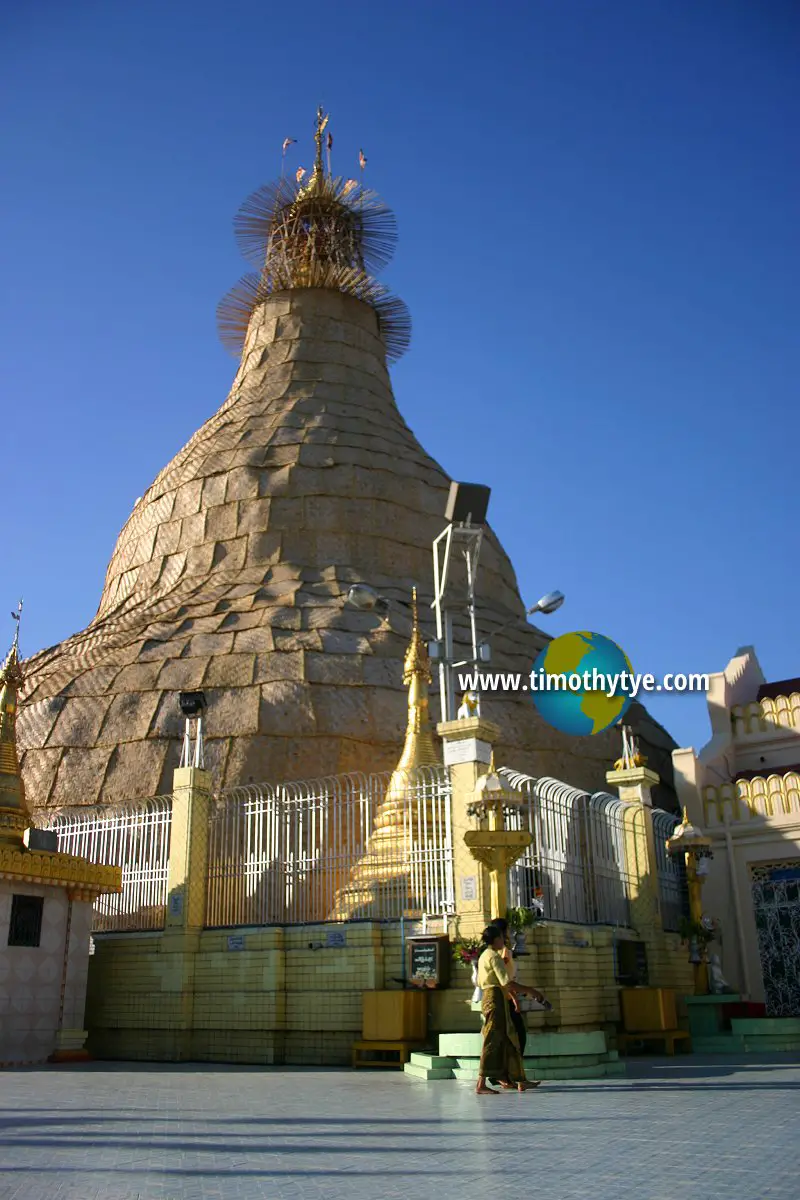 During our visit, the Botataung Pagoda was being restored. (20 November, 2003)
During our visit, the Botataung Pagoda was being restored. (20 November, 2003)
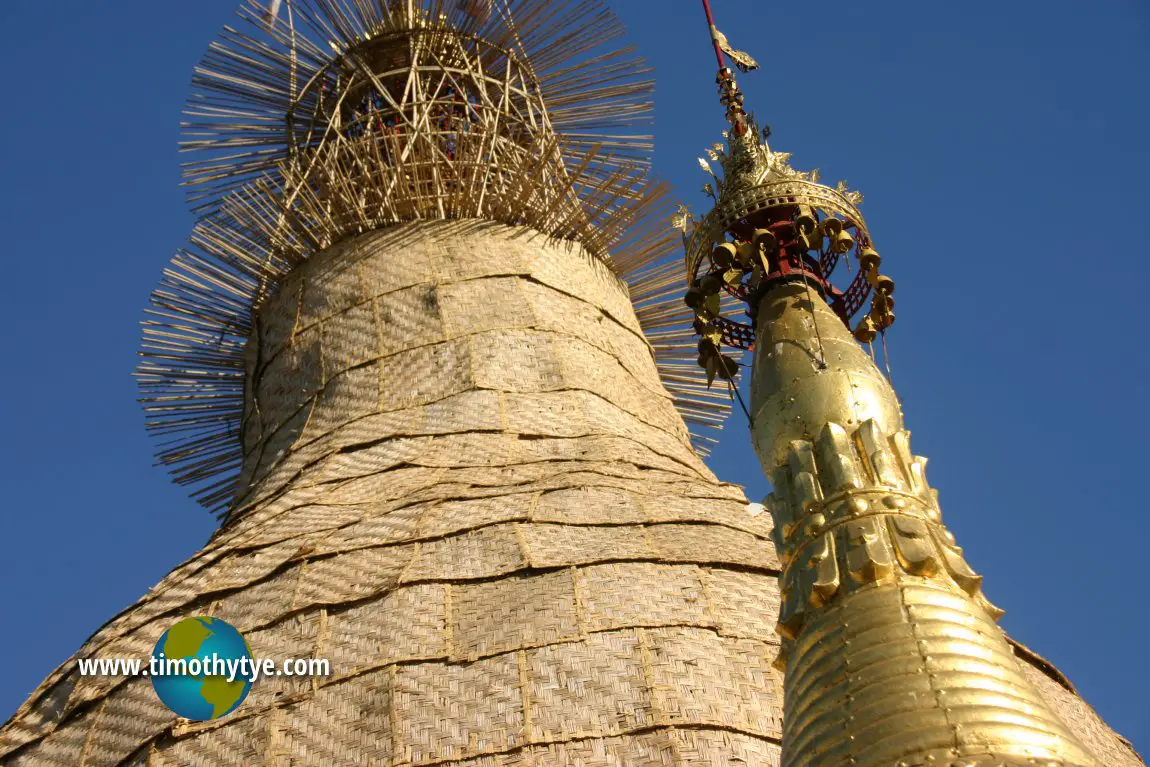 Botataung Pagoda being restored. (20 November, 2003)
Botataung Pagoda being restored. (20 November, 2003)
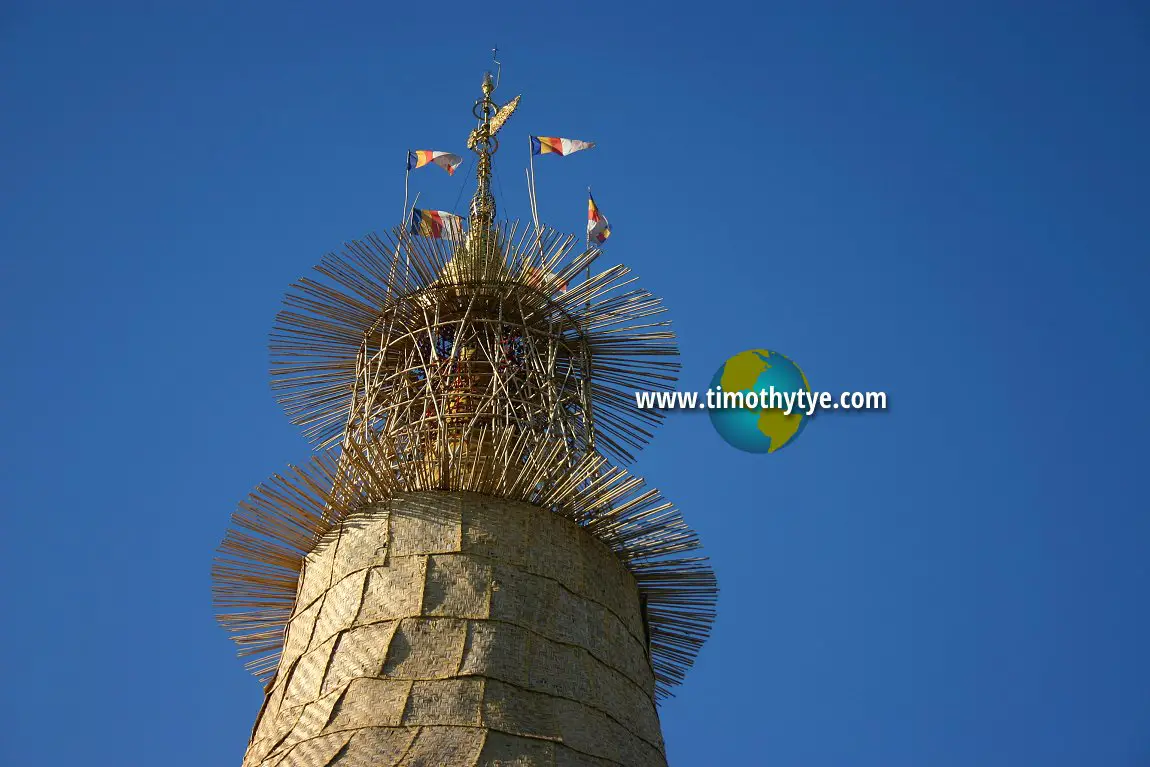 The umbrella-shaped spire, called hti, being restored. (20 November, 2003)
The umbrella-shaped spire, called hti, being restored. (20 November, 2003)
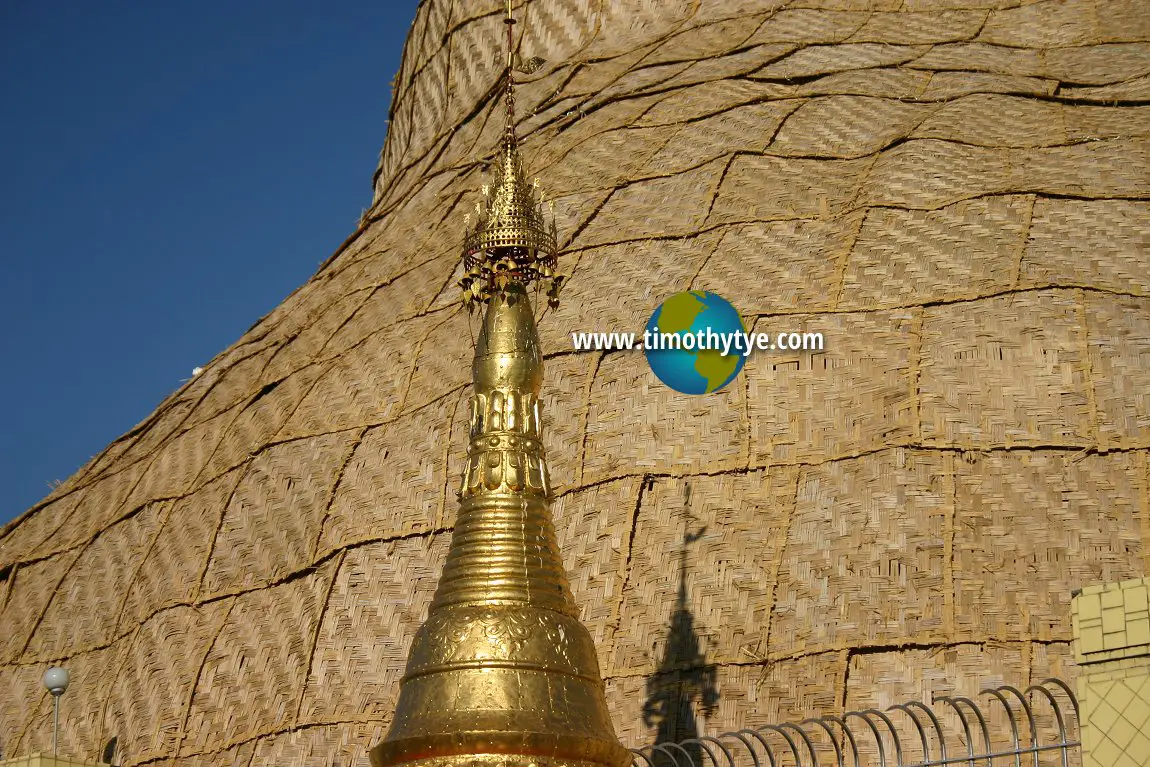 A smaller pagoda, fully restored, stands next to the main pagoda. (20 November, 2003)
A smaller pagoda, fully restored, stands next to the main pagoda. (20 November, 2003)
 Another view of the pagodas of Botataung. (20 November, 2003)
Another view of the pagodas of Botataung. (20 November, 2003)
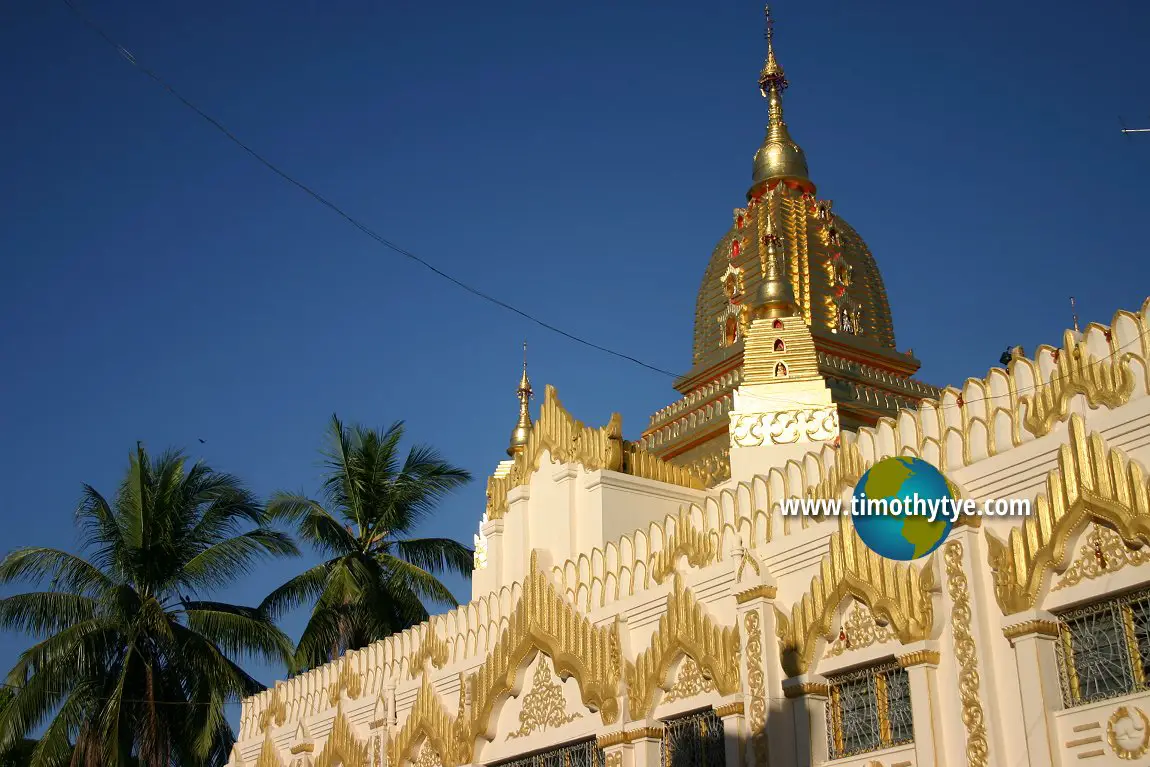 Botataung Pagoda stupa resplendent in the evening sun. (20 November, 2003)
Botataung Pagoda stupa resplendent in the evening sun. (20 November, 2003)
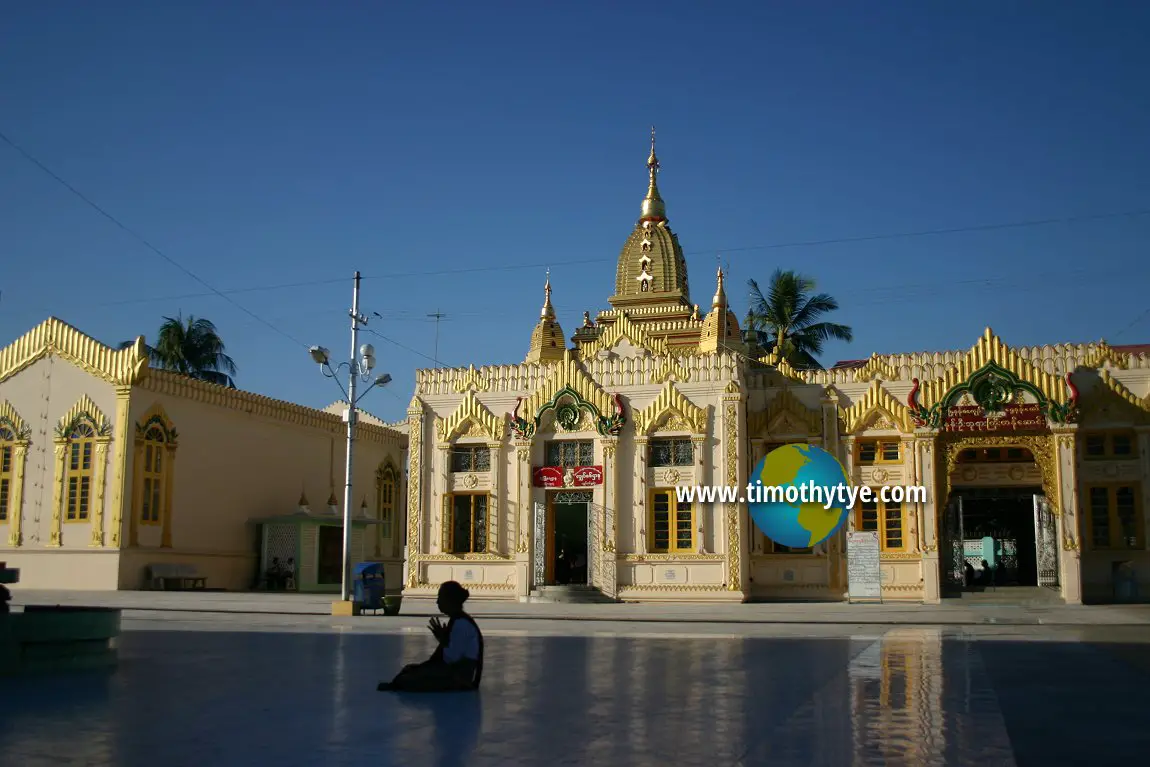 Devotee at Botataung Pagoda. (20 November, 2003)
Devotee at Botataung Pagoda. (20 November, 2003)
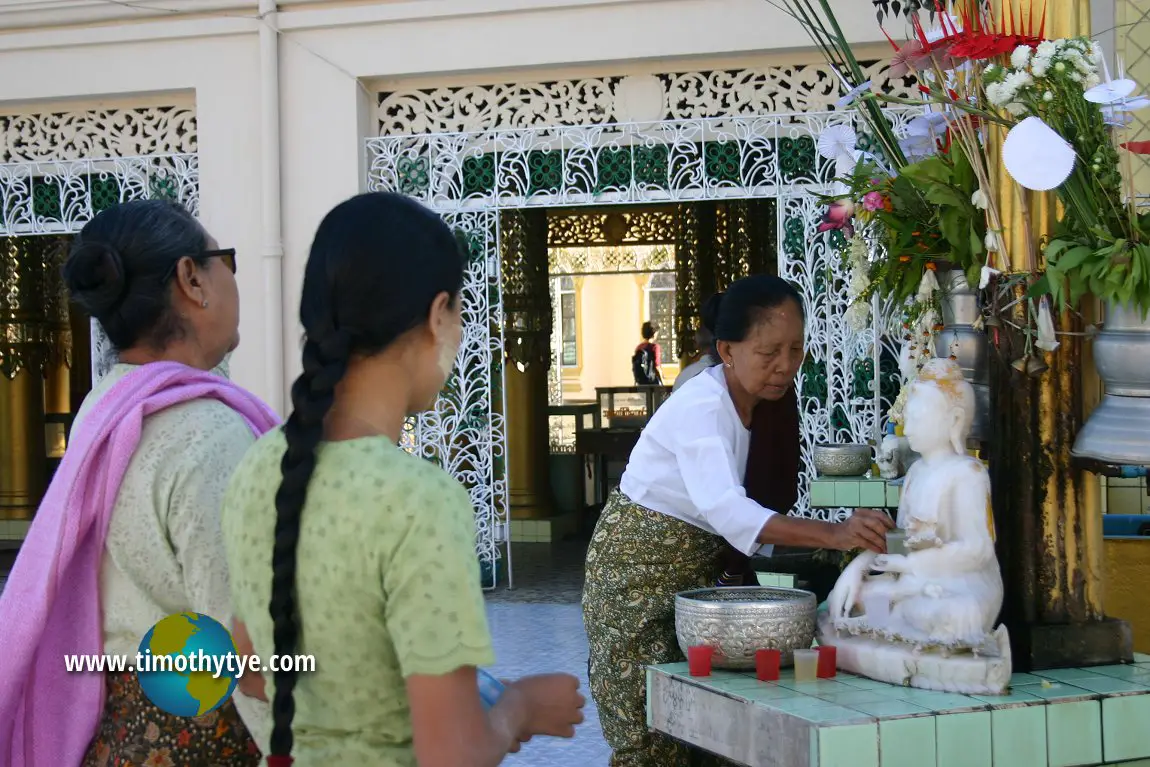 Devotees tending to a Buddha statue at Botataung Pagoda. (20 November, 2003)
Devotees tending to a Buddha statue at Botataung Pagoda. (20 November, 2003)
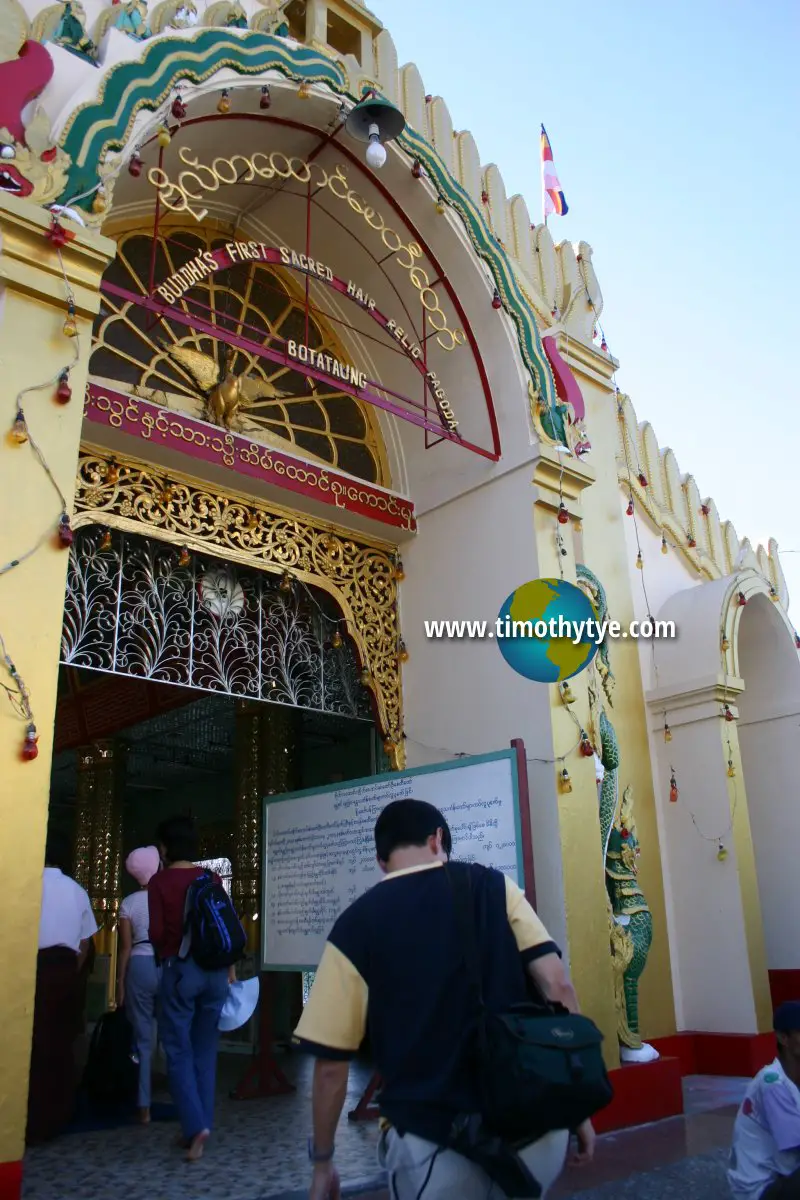 Entering Botataung Pagoda (20 November, 2003)
Entering Botataung Pagoda (20 November, 2003)
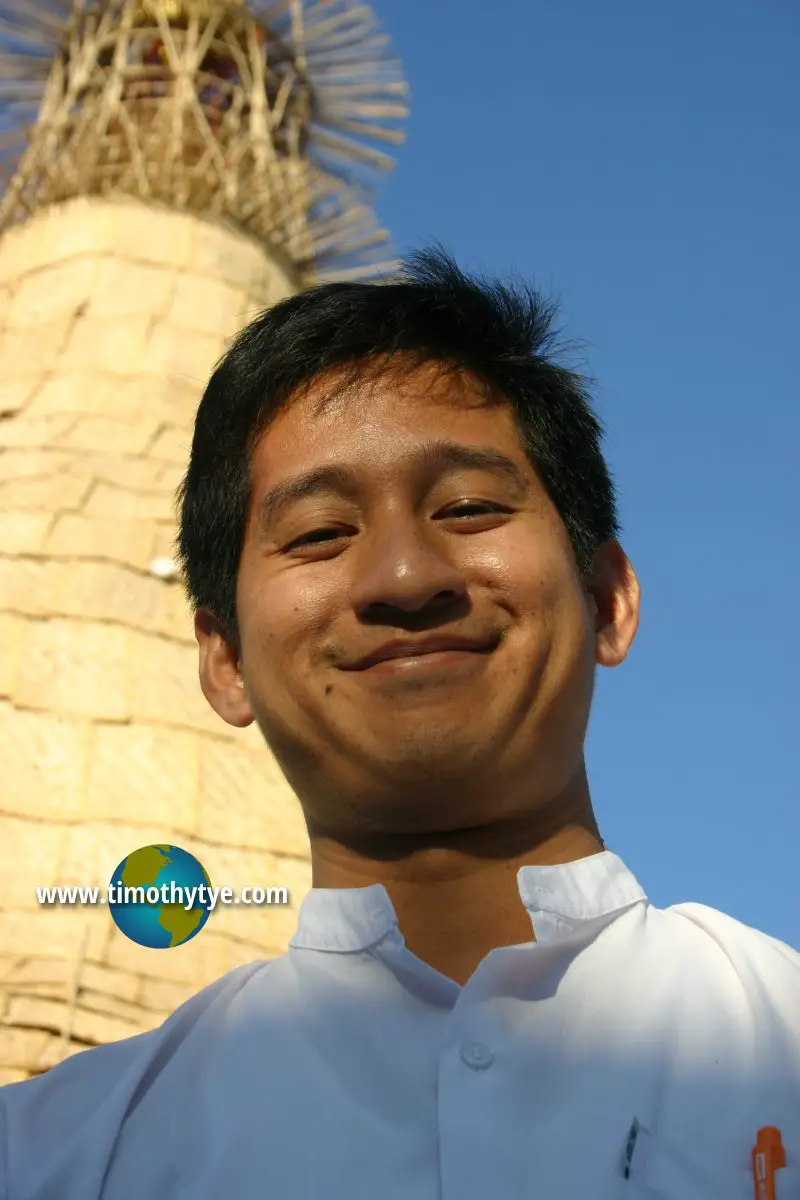 Mr Henry Yang, now the Managing Director of Myanmar Golden Image Travels & Tours, was our tour guide at Botataung Pagoda. (20 November, 2003)
Mr Henry Yang, now the Managing Director of Myanmar Golden Image Travels & Tours, was our tour guide at Botataung Pagoda. (20 November, 2003)
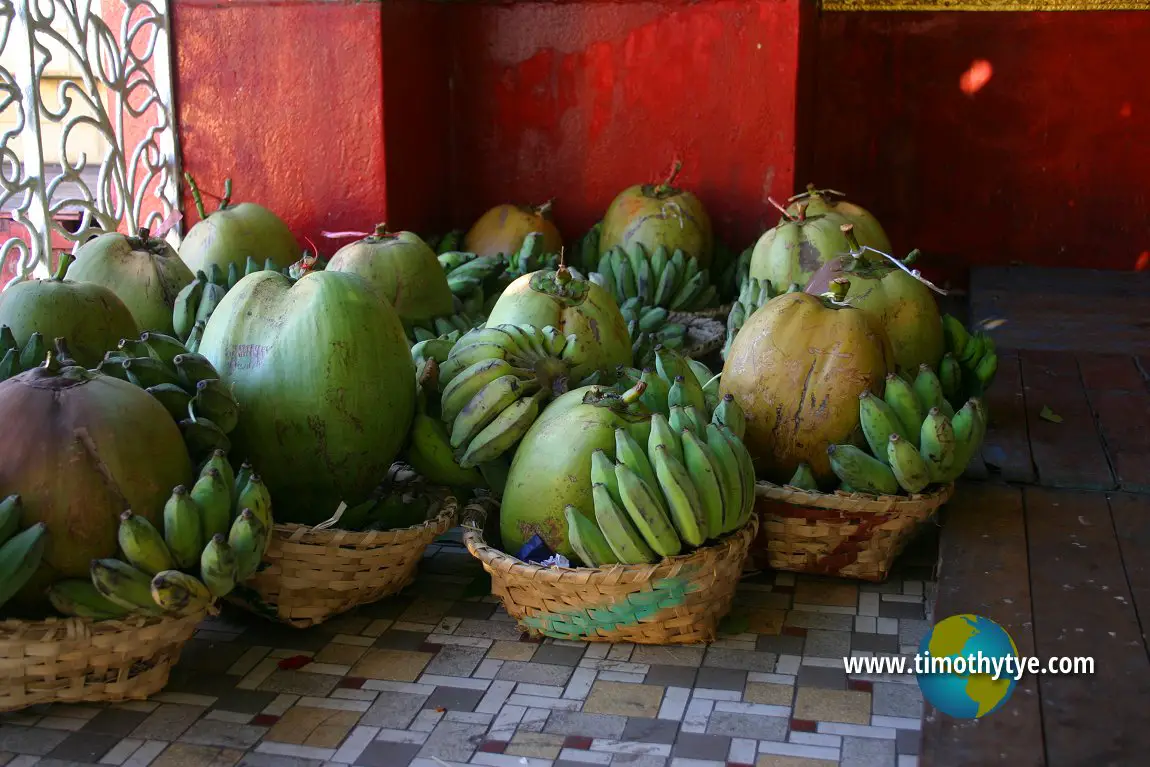 Offerings of bananas and coconuts. (20 November, 2003)
Offerings of bananas and coconuts. (20 November, 2003)
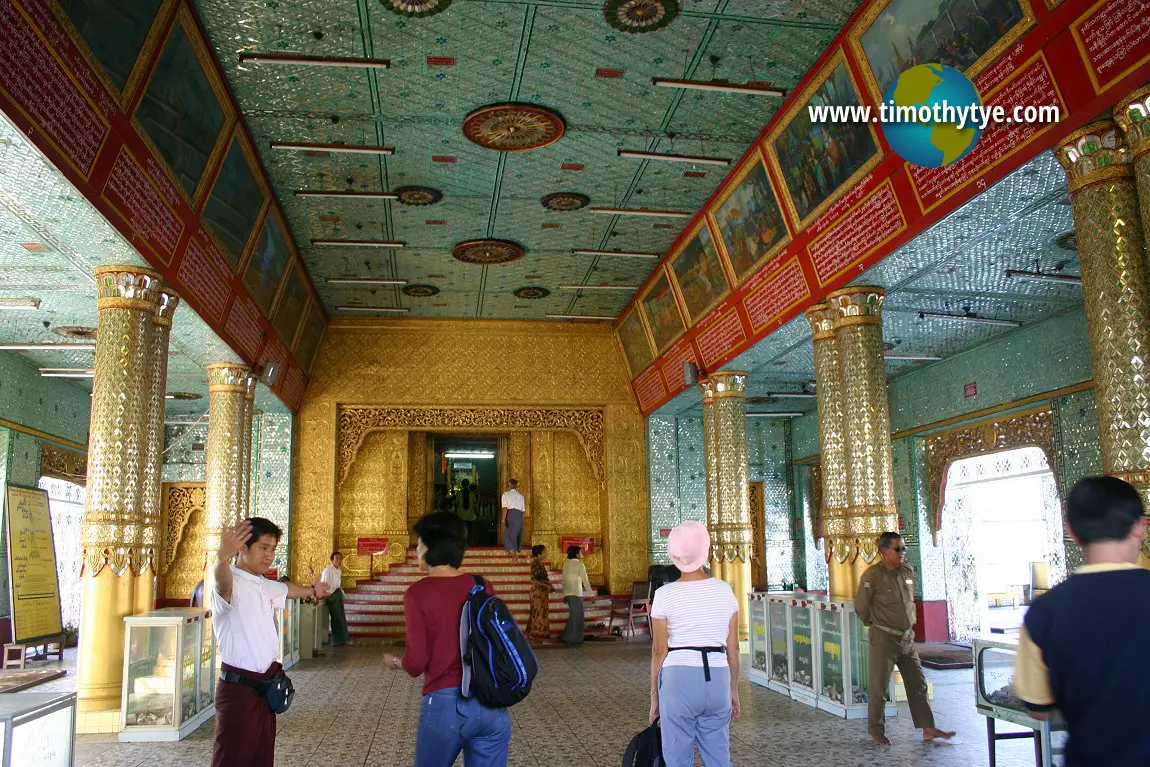 Our tour guide, Mr Henry Yang, welcoming us to Botataung Pagoda (20 November, 2003)
Our tour guide, Mr Henry Yang, welcoming us to Botataung Pagoda (20 November, 2003)
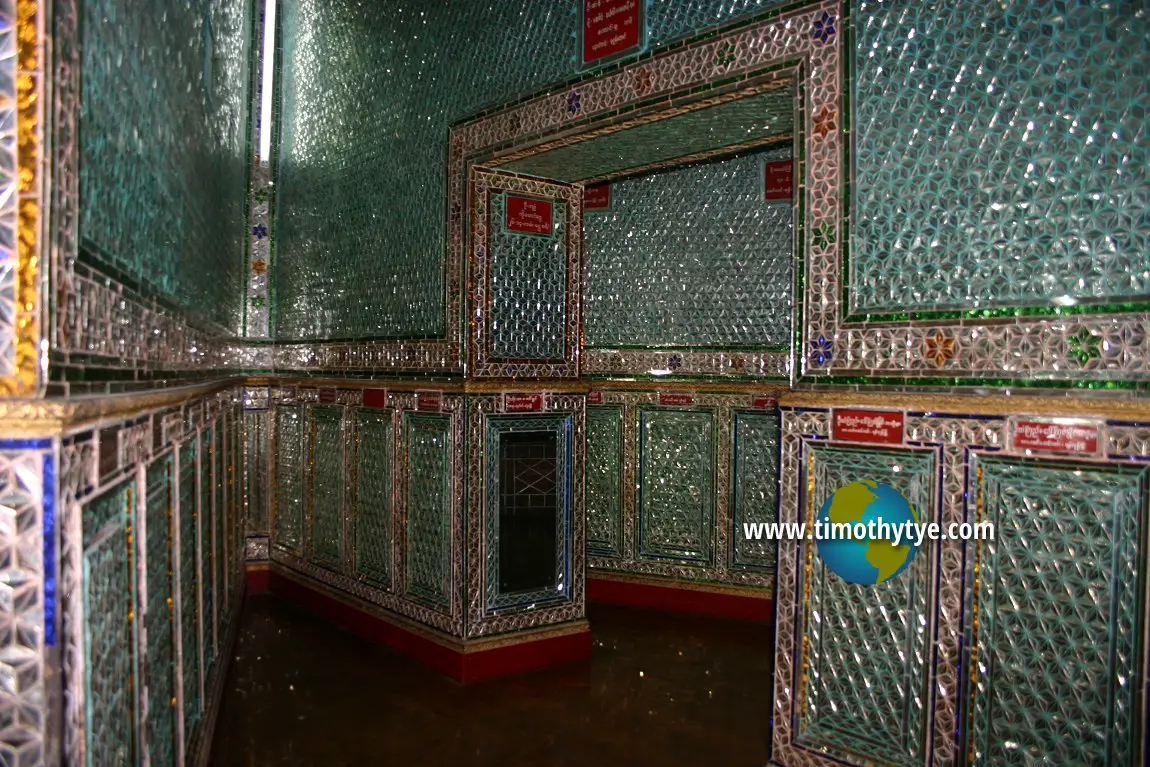 The walls inside Botataung Pagoda are inlaid with glass mosaic. (20 November, 2003)
The walls inside Botataung Pagoda are inlaid with glass mosaic. (20 November, 2003)
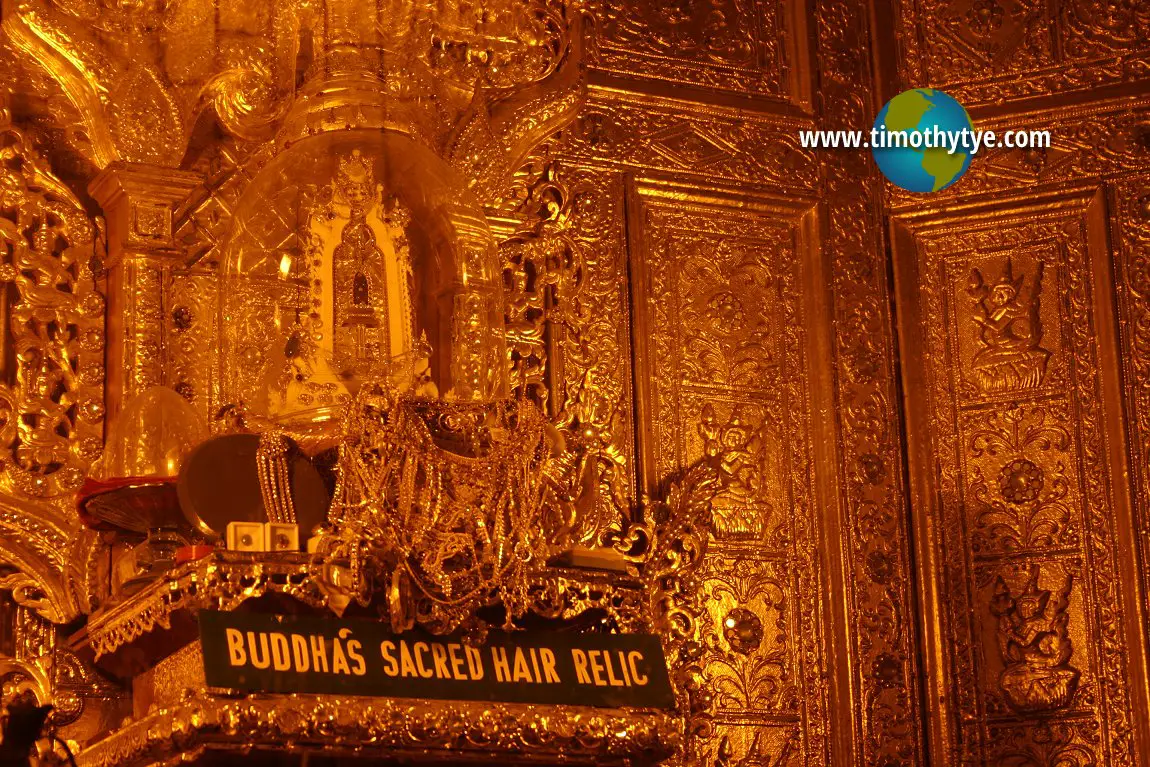 Close up on the Buddha Hair Relic at Botataung Pagoda. (20 November, 2003)
Close up on the Buddha Hair Relic at Botataung Pagoda. (20 November, 2003)
Discovering of the Botataung Treasure Vault
After the driving in of the gold pegs the debris was cleared, and the precious items including gold and silver images, coins and ornaments, were recovered. At a depth of three feet an ancient chamber was uncovered. It was 20 ft by 20 ft and 6 ft in height, gradually decreasing in size towards the top to appear like a huge pot placed up-sided down to cover completely what lay inside.In the centre of this treasure vault was a stone casket in the shape of a pagoda with a diameter of 23 ins, and 39 ins in height. Encircling this stone casket were figures of Nats (spirits or Minor Deities) carved out of laterite and evidently placed there to act as sentinels. The casket was immersed in mud as water had trickled into the vault during the many centuries it had been there.
Within this pagoda-shaped stone casket were various kinds of treasures: precious stones, ornaments, jewellery, terra-cotta plaques and images of gold, silver, brass and stone. The total number of these images recovered from the relic chamber was seven hundred. There were also terra cotta plaques, some of them in a fair state of preservation, depict Buddhist scenes.
One of the terra-cotta plaques bears an image of the Buddha. Although it had been affected by age and moisture, it was still exceptionally important. On the reverse side are inscribed characters which are very close to the ancient Brahmani script which came from Southern India. It is a precious evidence of ancient times and has been deciphered by U Lu Pe Win, the superintendent archaeologist, who pointed out that the initial word "e" from "evam vadi" shows that the script is in the manner of the ancient Mons. This is proof of the belief that the people who erected the Pagoda in ancient times were the Mons.
Botataung Stone Casket is opened
It was at once realised that the stone casket contained relics, but as this could not be opened unceremoniously, the pilgrims who had flocked here from all over Burma had to just imagine its contents. The Rehabilitation Committee met on several occasions but could not take the responsibility of opening the casket.A meeting was called to which 15 of the leading religious leaders (Maha Theras) attended. At this meeting, on the advice of these Bhikkhus, that as an act prompted by good motives and religious faith it would be quite meritorious to open the casket, it was unanimously decided that it should be done in the presence of the members of the Committee and the public. Great precautions were taken so as not to cause the slightest damage. Actually, the cone was removed from the stone salver on which it stood without any difficulty. When this cone or stone layer was removed there was found inside another stone layer of similar shape but with a brilliant gold coating and this was more representative of a pagoda in shape while its exquisite workmanship and brilliance inspired feelings of deep religious fervour in the crowd present. Some mud had penetrated even here and the sides of the base were covered with this. When it was washed and sifted, precious stones, gold and jewellery were discovered round the base. This second stone casket was then removed and inside was found a small pagoda of pure gold standing on a silver salver or base and beside this golden pagoda was a carved stone image 4 1/2 inches high of very ancient workmanship.
When the gold Pagoda was lifted up, a tiny gold cylinder of 3/4 inches in length with a diameter of 5/12 inches was found, and in this tiny cylinder were found two small body relics each the size of a mustard seed and a Sacred Hair of the Buddha. This hair was coiled round and fastened with a little acquer on which were traces of gold plaster.
The body and hair relics of the Buddha, along with all the images and other precious objects recovered from the ruins of the Botataung Pagoda were temporarily stored in a shelter near the site of the Pagoda. Meanwhile the building of a new pagoda got underway. The new pagoda follows the original design and has a height of 131 ft. 8 ins, with a base of 96 ft. by 96 ft. The pagoda is built of reinforced concrete and is to be gilded. It was decided that the pagoda was to be completed before the Sixth Buddhist Synod which was to be held in Burma in 1954.
Unlike many of the older shrines, the Botataung Pagoda does not have a solid core but has a huge internal cavity where worshippers may enter.
Botataung Pagoda is  on the map of Yangon
on the map of Yangon
 Latest updates on Penang Travel Tips
Latest updates on Penang Travel Tips
 Map of Roads in Penang
Map of Roads in Penang
Looking for information on Penang? Use this Map of Roads in Penang to zoom in on information about Penang, brought to you road by road.About this website

Dear visitor, thank you so much for reading this page. My name is Timothy Tye and my hobby is to find out about places, write about them and share the information with you on this website. I have been writing this site since 5 January 2003. Originally (from 2003 until 2009, the site was called AsiaExplorers. I changed the name to Penang Travel Tips in 2009, even though I describe more than just Penang but everywhere I go (I often need to tell people that "Penang Travel Tips" is not just information about Penang, but information written in Penang), especially places in Malaysia and Singapore, and in all the years since 2003, I have described over 20,000 places.
While I try my best to provide you information as accurate as I can get it to be, I do apologize for any errors and for outdated information which I am unaware. Nevertheless, I hope that what I have described here will be useful to you.
To get to know me better, do follow me on Facebook!
Copyright © 2003-2025 Timothy Tye. All Rights Reserved.

 Go Back
Go Back